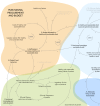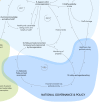Identifying mechanisms that shape the food environment in long-term healthcare facilities in the Netherlands: a participatory system dynamics approach
- PMID: 39881282
- PMCID: PMC11780851
- DOI: 10.1186/s12889-024-21124-1
Identifying mechanisms that shape the food environment in long-term healthcare facilities in the Netherlands: a participatory system dynamics approach
Abstract
Background: Creating healthy and sustainable food environments within long-term healthcare facilities asks for a systemic approach. This study aimed to: (1) identify system dynamics underlying the food environment of long-term healthcare facilities, (2) formulate actions for changing the system to promote a healthy and sustainable food environment and (3) evaluate stakeholder perspectives about the process and progress towards action implementation up to one-year follow-up.
Methods: A group model building (GMB) approach was used during two workshops with stakeholders of five different long-term healthcare facilities in the Netherlands. Stakeholders created a causal loop diagram (CLD) and formulated actions for change. Interviews were conducted at six- and twelve months to evaluate perspectives on the GMB process and progress towards action implementation.
Results: The developed CLD consisted of 30 factors influencing the food environment in long-term healthcare facilities and four interrelated subsystems (patient; healthcare organization; national governance and policy; purchasing, procurement and budget). Stakeholders formulated 40 corresponding actions. After one year follow-up, small steps towards action implementation were observed (e.g., agenda setting, raising internal awareness, formulating plans), with several barriers hindering implementation being noted (e.g., lack of time, budget, priority).
Conclusions: This study gained a comprehensive, collectively acknowledged understanding of the system dynamics underlying the food environment in Dutch long-term healthcare institutions. The results underscore the importance of crafting a coherent set of actions that addresses various factors and underlying mechanisms to initiate systemic change. However, achieving actual system changes in long-term healthcare facilities requires prolonged efforts and overcoming barriers towards implementation.
Keywords: Causal loop diagram; Food environment; Group model building; Healthcare institution; Long-term care; System dynamics.
© 2024. The Author(s).
Conflict of interest statement
Declarations. Ethics approval and consent to participate: The study was approved by the Social Sciences Ethics Committee of Wageningen University & Research (ethical approval number: 2021-38-Wierda) and the study complies with the Netherlands Code of Conduct for Research Integrity. All participants provided informed consent to participate. The study followed all procedures in accordance with the relevant guidelines and regulations of the Declaration of Helsinki [52]. Consent for publication: Not applicable. Competing interests: The authors declare no competing interests.
Figures







Similar articles
-
Systems thinking for local food environments: a participatory approach identifying leverage points and actions for healthy and sustainable transformations.Health Res Policy Syst. 2024 Aug 12;22(1):101. doi: 10.1186/s12961-024-01199-3. Health Res Policy Syst. 2024. PMID: 39135050 Free PMC article.
-
Understanding the underlying systems dynamics contributing to the continued predominance of the unhealthy motorway food environment in the Netherlands: identifying leverage points and actions for change.BMC Med. 2025 May 13;23(1):279. doi: 10.1186/s12916-025-04088-w. BMC Med. 2025. PMID: 40361126 Free PMC article.
-
Characterizing food environments of hospitals and long-term care facilities in the Netherlands: a mixed methods approach.BMC Health Serv Res. 2024 Jan 4;24(1):31. doi: 10.1186/s12913-023-10399-6. BMC Health Serv Res. 2024. PMID: 38178121 Free PMC article.
-
FERTILITY CARE IN LOW AND MIDDLE INCOME COUNTRIES: Implementing fertility care: insights from a participatory workshop in The Gambia.Reprod Fertil. 2024 Nov 7;5(4):e240029. doi: 10.1530/RAF-24-0029. Print 2024 Oct 1. Reprod Fertil. 2024. PMID: 39331764 Free PMC article. Review.
-
Why do acute healthcare staff behave unprofessionally towards each other and how can these behaviours be reduced? A realist review.Health Soc Care Deliv Res. 2024 Aug;12(25):1-195. doi: 10.3310/PAMV3758. Health Soc Care Deliv Res. 2024. PMID: 39239681 Review.
References
-
- Sloane PD, Ivey J, Helton M, Barrick AL, Cerna A. Nutritional issues in Long-Term Care. J Am Med Dir Assoc. 2008;9:476–85. - PubMed
-
- Thibault R, Abbasoglu O, Ioannou E, Meija L, Ottens-Oussoren K, Pichard C, et al. ESPEN guideline on hospital nutrition. Clin Nutr. 2021;40:5684–709. - PubMed
-
- Larson N, Story M. A review of Environmental influences on Food choices. Ann Behav Med. 2009;38:56–73. - PubMed
-
- Giskes K, van Lenthe F, Avendano-Pabon M, Brug J. A systematic review of environmental factors and obesogenic dietary intakes among adults: are we getting closer to understanding obesogenic environments? Obes Rev. 2011;12:e95–106. - PubMed
MeSH terms
LinkOut - more resources
Full Text Sources
Medical

